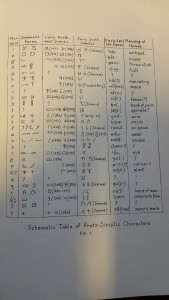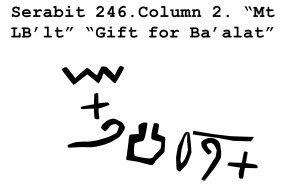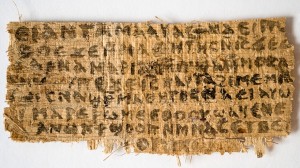The Proto-Sinaitic Inscriptions 2.0: Canaanite Language and Canaanite Script, Not Hebrew
The Proto-Sinaitic Inscriptions 2.0: Canaanite Language and Canaanite Script, Not Hebrew
Dr. Christopher Rollston (rollston@gwu.edu), George Washington University
Doug Petrovich has proposed in a paper presented on November 17th, 2016 at the annual meeting of the American Schools of Oriental Research and in a forthcoming volume (Jerusalem: Carta) that the Proto-Sinaitic Inscriptions from Serabit el-Khadem and Wadi el-Hol are Hebrew. This is quite a claim, but it will find few takers among those who actually know the scripts and languages of ancient Semitic inscriptions written in linear alphabets.
After all, the inscriptions from Serabit el-Khadem and Wadi el-Hol can be dated to ca. the 18th century BCE. But the earliest inscriptions written in the distinctive Old Hebrew script can be dated with substantial certitude to the 9th century BCE. And the script of the actual Old Hebrew inscriptions is very, very different from the script of the inscriptions from Serabit el-Khadem and Wadi el-Hol. In fact, no one who has formal training in these different scripts would ever confuse them or suggest that they were the same. I’ll get back to this point in a moment, but first a little history.
There is nothing all that new about Petrovich’s proposal. After all, more than ninety years ago, H. Grimme wrote a volume entitled _Althebräische Inschriften vom Sinai_ (Hannover, 1923) in which he argued that the inscriptions from Serabit el-Khadem were Hebrew. Grimme can almost be forgiven, because he wrote before the discovery of Ugaritic. Almost. But even then, his views didn’t find many takers, as he was manipulating the evidence to the point that his proposal had more twists and turns than a dirt road in a Tennessee holler.
In fact, here is what the great epigrapher Joseph Naveh (d. 2011) of Hebrew University (Jerusalem) said about Grimme’s proposal: “There were scholars who tried to relate this script to the Israelites, who after the Exodus lived for a generation in the Sinai Peninsula. Nowadays these romantic views are no longer accepted” (Naveh, _Early History of the Alphabet_ 1987, 26). Similarly, A. van den Branden argued (in an article entitled “Les inscriptiones protosinaitiques,” published in 1962 in _Oriens Antiquus_ 1, pp. 197-214) that the inscriptions from Serabit el-Khadem were written in a South Semitic language that is attested on various South Arabian monuments. Neither of these proposals gained any traction with people who knew multiple Semitic languages and scripts…because these proposals were based on erroneous and partial understandings of the actual inscriptional evidence.
I’m sure that Grimme and van den Branden were well intentioned, and I believe that Petrovich is as well. But the evidence is weighty, and the evidence demonstrates the following: the inscriptions from Serabit el-Khadem and Wadi el-Hol (and various other second millennium sites, etc.) are written in a Northwest Semitic dialect of the early Second Millennium BCE. In terms of the name for this language, the most apt term is “Canaanite.” After all, there is nothing distinctively Phoenician, or Hebrew, or Aramaic, or Moabite, or Ammonite, or Edomite about the words in these inscriptions that would reasonably allow someone to call the language of these inscriptions by one of those terms. Indeed, the words in the inscriptions from Serabit el-Khadem and Wadi el-Hol are found in lots of Semitic languages, not just one. Thus, the best term of the language of these inscriptions is “Canaanite.”
And as for the script of these inscriptions from Serabit el-Khadem and Wadi el-Hol, the best terms are “Early Alphabetic,” or “Canaanite.” Some prefer the term “Proto-Sinaitic Script.” Any of these terms is acceptable. But it is absolutely and empirically wrong to suggest that the script of the inscriptions from Serabit el-Khadem and Wadi el-Hol is the Hebrew script, or the Phoenician script, or the Aramaic script, or the Moabite script, or the Ammonite script, or the Edomite script. The script of these inscriptions from Serabit el-Khadem and Wadi el-Hol (etc.) is not one of the distinctive national scripts (such as Phoenician or Hebrew or Aramaic, etc.), but rather it is the early ancestor of all of these scripts and we term that early ancestor: Early Alphabetic. Here is the precise derivation: first came the Early Alphabetic script (e.g., of the inscriptions from Serabit el-Khadem and Wadi el-Hol, dating to ca. 18th century BCE), and from this Early Alphabetic script (which continued to be used in the Levantine world for several centuries) came the Phoenician script (in ca. the late 11th century BCE and the early 10th century BCE). And from the Phoenician script came the Old Hebrew script (in the 9th century BCE) and the Aramaic script (8th century BCE). And it should be emphasized that the Hebrew script was developed in the homeland, that is, Israel (and that explains why it is first attested there).
Here are some of the features of the Early Alphabetic script. It could be written from left-to-right (for which we sometimes use the fancy word “dextrograde”), right-to-left (for which we sometimes use the fancy word “sinistrograde”), boustrophedon (which means the first line was written from left-to-right and the one below it was written from right-to-left, and so on…interestingly, the term “boustrophedon literally means “as the ox plows”), and columnar (which means: written from top to bottom, as in a column, rather than on a horizontal plane). In addition, in the Early Alphabetic script, the letters were very pictographic in nature and they would “face” one way if you were writing left-to-right and they’d face the other way if you were writing right-to-left. In addition, the Early Alphabetic script had twenty-seven letters. I’ve included here a scan of W.F. Albright’s chart of those letters.
However, Phoenician, Hebrew, and Aramaic (etc.) are consistently written from right-to-left (not in any of the other options, listed above). And Phoenician, Hebrew, and Aramaic always “face” the same direction (because they are always written in the same direction, that is, from right-to-left). And Phoenician, Hebrew, and Aramaic (etc.) all have twenty-two letters in their alphabet (as demonstrated by Hebrew inscriptions that list the Hebrew “abc’s” in order, and also by Biblical alphabetic acrostics, such as Psalm 119, etc.), not twenty-seven, of course. And, on top of all this, the shapes (“morphology”) of the letters of the Phoenician, Hebrew, and Aramaic letters are often quite different from the shapes of the Early Alphabetic letters. In short, the difference between the Early Alphabetic script and the Old Hebrew script is night and day. Even a novice can be trained to tell the difference in a matter of minutes. In fact, I have actually tried this in class at times and even undergraduates can rapidly be taught which is which. It’s not rocket science.
So….let’s now continue with a little more history and a little more data…
The oldest inscriptions written in a distinctive Old Hebrew script can be dated with certitude to the 9th century BCE (some have suggested perhaps the 10th century…that too is fine), as the great Joseph Naveh of Hebrew University argued (1982, _Early History of the Alphabet_, 65-66), and as I too have argued (e.g., in my “Northwest Semitic Cursive Scripts” article in the Frank Moore Cross memorial volume entitled _An Eye for Form_, 202-234). We know an enormous amount about the history and development of the Hebrew script through time, as we have hundreds and hundreds of Hebrew inscriptions from the 9th through 6th centuries BCE (less for the earlier periods than the later periods, but still, many, many inscriptions and lots of evidence, therefore).
These inscriptions from Serabit el-Khadem and Wadi el-Hol arguably date to ca. the 18th century BCE. The Serabit el-Khadem inscriptions have been known for more than a century (Petrie, Researches in Sinai, 1906), and a decade after their discovery, A. Gardiner discerned that these inscriptions were written in a very early form of the Semitic Alphabet. Indeed the title of his seminal article on the subject is “The Egyptian Origin of the Semitic Alphabet” (JEA 3, 1916, 1-16). The Wadi el-Hol inscriptions had been discovered some time ago, but were studied and formally published just around a decade ago (Darnell, Dobbs-Allsopp, Lundberg, McCarter, Zuckerman, 2005). Inscriptions written in this same Early Semitic Alphabetic script (though dating to later centuries) have been found at additional sites, including Lachish and Gezer (i.e., sites in the Levant).
These inscriptions have been studied heavily through the years, with the publications by scholars such as W.F. Albright (_The Proto-Sinaitic Inscriptions and Their Decipherment_, 1966), F. M. Cross (written primarily in the 1960s-1990s and all collected in his volume entitled _Leaves from an Epigrapher’s Notebook_ Eisenbrauns, 2003), P. K. McCarter’s published dissertation (_The Antiquity of the Greek Alphabet and the Early Phoenician Scripts, 1975), B. Sass’s published dissertation (entitled _The Genesis of the Alphabet and Its Development in the Second Millennium B.C._ 1988), G. Hamilton’s 1985 Harvard dissertation and its augmented published form (entitled _The Origins of the West Semitic Alphabet in Egyptian Scripts_, 2006), various substantive and important articles by O. Goldwasser (referenced or archived at https://huji.academia.edu/orlygoldwasser ), the volume by S. Sanders (entitled _The Invention of Hebrew_, 2009), as well as some publications by me on the subject of the Early Semitic Alphabet, the Phoenician alphabet, and the Old Hebrew alphabet (a number of these are referenced or archived at https://gwu.academia.edu/ChristopherRollston). And this is only a very partial list. The bibliography is really quite vast.
And now on to say a little more about Petrovich’s proposal, keeping the above background in mind…
I noted in my previous post on this subject (http://www.rollstonepigraphy.com/?p=763) that various words that Petrovich was stating were distinctively Hebrew were actually Common Semitic (a term that means that those words are found in multiple Semitic languages, not just one or two). Here is Petrovich’s response to me: “I assert the reading rb “many, abundant” and yn “wine” to be Hebrew words in the context of the [Serabit el-Khadem] inscription.” That’s fascinating, as he is conceding that these words are Common Semitic and he is saying that they are Hebrew in the Serabit el-Khadem inscriptions because he says that these inscriptions are Hebrew. That is, of course, a textbook case of circular reasoning. After all, the script is definitively *NOT* the Old Hebrew script and the roots rb “many, abundant,” and yn “wine” are attested in multiple Semitic languages (and in the case of “wine” even in non-Semitic languages!), thus, there is no evidence forming the basis for a declaration that the inscriptions are Hebrew.
But let’s look at more of Petrovich’s evidence. Thus, in his response to my previous blog post, he posited that “in Sinai 349 the Hebrew word tl(y) ‘quiver’” is used. He believes this word is distinctively Hebrew, that is, a smoking-gun demonstration of the fact that Sinai 349 is Hebrew. So, let’s look at the actual evidence, and I’ll even go with his reading (i.e., tav lamed) for the sake of argument. That is, he reads tl here and let’s see if those two letters must mean “quiver.” …Well, a quick look at the lexicon reveals the following: ….well, there’s a word (as many people know, even if they don’t know any Semitic languages) that occurs in multiple ancient Semitic languages that means “ruins” and it is spelled tl. In addition, there is a word for “to attach, or hang” that occurs in multiple Semitic languages that would be spelled tl in this period (root tlh). Moreover, anyone trained in Semitic languages would know that tl could represent the geminate Semitic root tll (to scheme, flirt). And there are even more options. In any case, Petrovich assumes that the only possible meaning for tl in Sinai 349 is “quiver,” but a quick look at the lexicon demonstrates that this assumption is erroneous. So much for those two letters demonstrating that Sinai 349 is Hebrew.
In Petrovich’s response to me he also states that “in Sinai 349 the Hebrew word ‘m (aleph mem) appears.” He also states that this is “the Hebrew word ‘m for “terror, dread” (and he also mentions that he believes that the final hey of the word ‘mh is a mater lectionis and that it would not be reflected in the early orthography….I could discuss that further, but this subject is well-known and so I’ll not delve into it here). And he states that “this word occurs only in Biblical Hebrew and Aramaic.” So, Petrovich reads the letters aleph and mem and he assumes that this must be the Hebrew word for “terror, or dread.” That is fascinating….but let’s look at a good dictionary again, as a diligent student would always do. And, lo and behold, there’s a word that jumps right off the page of the lexicon: the word “mother” is spelled aleph mem (and I suspect that a number of my readers already thought about the fact that the word “mother” is spelled aleph mem….and these readers, therefore, already knew that if you see the letters aleph + mem it isn’t necessarily the word for “dread, or terror”). And that word (i.e, aleph mem, “mother”) is attested across the Semitic languages, from Phoenician, and Ugaritic, to Hebrew and Aramaic, to Ethiopic (and beyond). And there’s more, if we keep looking…the word “if” is also spelled aleph mem. And the word for slave woman, maidservant is also spelled aleph mem (plus a hey mater) and it occurs in all kinds of Semitic languages, from Ugaritic, Phoenician, Aramaic, Hebrew, to Akkadian and Ethiopic. And the word for “forearm, cubit,” is also spelled aleph mem (and it’s attested in many ancient Semitic languages as well, including Ugaritic, Akkadian, Hebrew, Aramaic, and Ethiopic, etc). And alep mem is also the way to spell “tribe, people” and this word is also attested in multiple Semitic languages. Again, the problem here is that Petrovich assumes that the letters he reads as aleph mem must be some word that he considers to be distinctively Hebrew (i.e., a word for “terror or dread”) and so he views that word as being a demonstration that Sinai 349 is using a rare Hebrew word. But the problem is that he is making all sorts of assumptions and a quick look at any dictionary proves that his assumptions are just not correct.
The same goes for his reading of the word “Hebrew” in Sinai 119. Egyptologist Thomas Schneider has demonstrated nicely (in a guest post on my blog) that the word “Hebrew” is just not there (http://www.rollstonepigraphy.com/?p=771 ).
And the same can be said for Petrovich’s attempts to read the names of biblical people in these inscriptions. They are simply not there. I wish that they were. I would really like to see some references to more biblical people in the epigraphic record. In fact, I very much like the work of Lawrence Mykytiuk (e.g., his _Identifying Biblical Persons in Northwest Semitic Inscriptions of 1200-539 BCE_, SBL 2004….and various really sterling articles by Mykytiuk since the publication of his book). But the difference between Mykytiuk’s work and Petrovich’s is that Mykytiuk is really reading inscriptions carefully and accurately, considers all of the options, and draws reasonable conclusions.
Finally, I should like to emphasize that the issue is not one of faith versus academia or “not believing in the biblical exodus from Egypt.” In my case, I do believe there was an exodus from Egypt, and things such as the Beni Hasan Tomb, the painting in the tomb of Rekhmire, Papyrus Anastasi 5, and the Instruction of Merikare (all of which are discussed so very well by Nahum Sarna in an article entitled “Israel in Egypt,” published in a volume edited by H. Shanks and entitled _Ancient Israel_, 2nd ed. 1999) are pretty important pieces of evidence regarding the fact that there was some sort of an exodus. In short, it is not my disinclination to believe in the exodus that causes me to not embrace Petrovich’s proposal. I do believe that the evidence (biblical and extrabiblical) are sufficient to believe there was an exodus. So…it’s just Petrovich’s proposal that I find unconvincing. The evidence just doesn’t support his proposal.
Thus, in the end, the conclusion that must be drawn is that (1) the inscriptions from Serabit el-Khadem and Wadi el-Hol are written in the Early Alphabetic script (also called “Canaanite” and “Proto-Sinaitic”), not the Old Hebrew script (which we know so well from hundreds of inscriptions), and (2) the language of the inscriptions from Serabit el-Khadem and Wadi el-Hol is not the Hebrew, or Phoenician, or Aramaic language, but rather it is a West Semitic language or dialect that is best termed “Canaanite.” That’s it.





Recent Comments